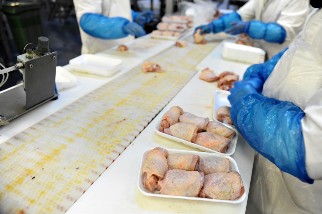 The COVID-19 pandemic is impacting all industries. A new resource from OSHA and CDC offers guidance on specific steps that employers in meat and poultry processing can take to protect their workers from the virus.
The COVID-19 pandemic is impacting all industries. A new resource from OSHA and CDC offers guidance on specific steps that employers in meat and poultry processing can take to protect their workers from the virus.
Specific conditions in meat and poultry processing are cause for concern due to the potential for exposure to respiratory droplet in the air and contact with contaminated surfaces, tools and workstations. For example, workers typically operate near one another on processing lines and may also come in contact while clocking in/out, in changing rooms or during breaks. Long shifts are also common.
To address these potential routes of exposure and protect worker health, the guidance offers several recommendations for preventive controls.
Install Engineering Controls
Physical (social) distancing is one of the strongest defenses against the spread of COVID-19. In meat and poultry processing, this can take the form of positioning workers six feet apart in all directions, and aligning processing stations so that workers do not face each other. In addition, employers can install physical barriers such as strip curtains or plexiglass partitions to separate workers.
In common areas where workers may congregate, such as clock in/out stations and break rooms, employers can stagger times to allow for smaller groups to be in those areas at any given time, and implement touch-free methods for clocking in and out.
Proper ventilation is another important tool for protecting workers’ health. If your facility uses pedestal or mounted fans, be sure they positioned to minimize air blowing from one worker to another worker.
Implement Administrative Controls
Physical distancing can also serve as an administrative control. Employers should encourage single-file movement with a six-foot distance between each worker through the facility, and install Visual cues such as signs and floor markings to remind workers throughout the day. Staggering worker arrival, break and departure times will also limit the number of workers in certain areas at particular times.
OSHA and CDC also advise employers to modify production/processing lines and shifts to maintain their processing capacity while preventive measures are in place. For instance, a processing plant could split one shift into two or three during a 24-hour period, possibly designating one shift for cleaning and disinfecting.
Other potential administrative controls include providing hand sanitizer, soap, water and towels for handwashing, as well as educating workers on the importance of proper hygiene, such as not touching their eyes, nose or mouth.
Following Cleaning and Disinfecting Protocols
Employers also need to ensure that tools and equipment are cleaned and disinfected. For tool-intensive operations, tools should be cleaned and disinfected whenever workers change workstations or move to a new set of tools. EPA provides guidance on disinfectants that meet its criteria for preventing the spread of COVID-19.
Moving forward, employers should sanitize work and common spaces more frequently, and disinfect frequently touched surfaces, such as push bars, handles and handrails, at least once per shift. Employers should also ensure that workers who perform cleaning and disinfecting have adequate protection against any chemical hazards associated with disinfectants.
Use Personal Protective Equipment (PPE)
PPE such as gloves, faceshields and eye protection are common in meat and poultry processing facilities. OSHA and CDC The guidance notes that while faceshields can provide additional protection from potential process-related splashes and potential person-to-person droplet spread, only some faceshields are acceptable substitutes for eye protection used to protect against impact.
Employers also can consider allowing voluntary use of filtering facepiece respirators (FFRs) during the pandemic, even if they are not a normal job requirement. With any PPE use, employers must verify that workers know how to properly use the equipment to avoid contamination. In addition, any PPE must be properly disinfected and stored when not in use.
Monitor Your Workforce
Along with all of these controls, employers’ need to closely monitor workers’ health. This could include screening workers before they enter the facility, encouraging sick workers to stay home and sending workers home if they come to work sick or become sick during the day.
If someone in your facility is diagnosed with COVID-19, you need to inform all those with whom the individual has had contact. Employers also should refer to CDC’s Public Health Recommendations for Community-Related Exposure to instruct their workers on how to proceed after coming into contact with someone who has tested positive for the virus.
Related Links
OSHA Issues Interim Guidance on Respirator Decontamination
OSHA to Consider Good-Faith Efforts for Compliance During COVID-19 Pandemic
Three Keys to Addressing COVID-19 in the Workplace
How Your Safety Management System Can Help in a Pandemic
Safety News You Need: Personal Protective Equipment